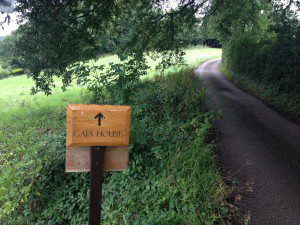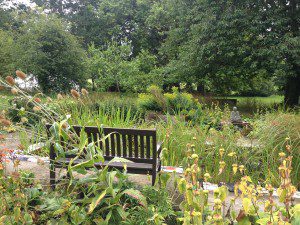Leigh Brasington’s Jhana retreat turned out to be an illuminating learning experience. There were some real highs and the typical challenges of being on a 9-day silent retreat. I had moments of energising bliss, followed by deeply-still happiness and then moments of just stillness alone without obvious positive emotion. I also had moments of my mind saying ‘why did you sign up for a silent retreat when you could have just taken a holiday, blah, blah, really important, blah blah’! These challenges came mostly off the cushion, when I was having lunch or going for a midday walk. On the cushion my mind was a lot more still and any internal narrative was in the background and I was able to let it be and continue with the Jhana practice (most of the time at least!).
It was lovely to be back in the idyllic setting of Gaia House. The food is wonderful and I really recommend it as a UK retreat centre with an illuminating set of teachers.
What about the questions I had before the retreat? (see part 1 of this article) I had chance to ask Leigh lots of questions in personal interview and also his Dharma talks provided many answers and a great depth of insight and knowledge.
Is it better to focus on ‘dry’ concentration, or concentration together with happiness/joy/bliss?
In the beginning of the practice it’s important that we are working with something that isn’t too engaging so it is harder to stay with the object and we work the mindfulness brain circuits more deeply e.g. the breath. But once we get to the stage where concentration activates more and more pleasure then switching to the happiness is not undermining concentration power. It is also fulfilling in of itself to develop the Jhana factors including happiness. They add to emotional wellbeing and complement the shaking up process of deep insight practice by providing a buffer of happiness.
How does ‘creating’ these blissful states relate to the aspect of mindfulness working with the ups and downs of life?
The concentration skills developed in Jhana practice provide the ‘power’ to engage in the insight practices that help with dealing with the challenges of life. I tend to teach two initial techniques for dealing with negative emotions – mainly influenced by Shinzen Young and Mingyur Rinpoche but also found in MBSR and MBCT. Focus away and focus towards. Jhana concentration supercharges both of these strategies. With focus away we allow the negative emotions to be present in the background and we use the Jhana concentration skills to stay with another aspect of the present moment – like sights and sounds, the breath or the feeling of compassion.
In focus towards we turn towards the emotion and deconstruct it into its component parts – the body sensations of emotion, the thoughts (internal image and narrative). Jhana concentration helps with the clarity to observe these different parts. When the microscope of concentration gets strong enough we see that emotional phenomena are made of many different parts and also that each component is changing moment to moment, this is classically described as insight into impermanence and can lead to more freedom. We find we can more easily cope with these individual changing parts when they are seen separately than when they combine together.
The happiness and peace from these practices are rewarding in of themselves – a deep experience of the bodies relaxation response. Regarding the ups and downs of life, the happiness of Jhana can work to raise our emotional set point to some extent over time. Leigh has collaborated on some fascinating research that showed his brain’s reward system (the Nucleus accumbens) was significantly firing up in the Jhana’s characterised by happiness and joy, and it seems that over time you can tip your brain toward this potential. Although this needs further studies to investigate but is anecdotally reported by Jhana practitioners.
How does Jhana relate to the insight practices related to the suffering caused by the effort and energy we put into creating a sense of self as permanent and individual?
Leigh emphasised that in the early teaching of the Buddha he placed special importance on achieving Jhana 1-4 and then using this concentration in insight practice (like the four foundations of mindfulness). We have talked about how Jhana helps to achieve the insight of impermanence and interdependence (realising and investigating how emotions are made of many components that are constantly changing).
Another insight is that there is no ‘thing’ called self inside us as a distinct solid and unchanging entity. This is confirmed by findings of neuroscience which show that there is no area of the brain where the self is located, it is composed of many different systems interacting and changing together including the wider nervous system of the body.
The state we develop from Jhana puts us into a relaxed and peaceful state for insight practice. This makes ‘do nothing’ practices where we relax all effort and ‘just be’ more simple. Also in choiceless awareness practices (observing the arising and passing of phenomena), when the surface thoughts quieten we tend to be working with more subtle thoughts and feelings which can lead to deeper freedom. However, I think it’s complimentary to be able to go right into insight in a moment without ‘warning up’, as these strategies can be most helpful when we get stressed in life.
The majority of meditation teachers recommend concentration practice with or without Jhana for the start of practice to build up concentration power. Beginning students might spend longer on this but as we advance we might spend longer with insight practice.
From a mindfulness/MBSR perspective you might spend longer on mindfulness of breathing and the body scan and less time on mindfulness of thoughts and emotions and choiceless awareness. Then in time this balance might reverse. This is the approach I work with, spending about a quarter of the time on concentration and the rest on insight. So this might be anything from 10mins to an hour on concentration before moving into watching thoughts and emotions, choiceless awareness or ‘do nothing’. Some days I go straight into insight to train that. I tend to use focus on the breath or metta to generate Jhana and cycle through the first 4 Jhana’s as Leigh teaches them. Maybe after many more years I might reach the deeper Jhana levels as taught by the likes of Pa Auk Sayadaw but this is good for now!
Happy practicing!
PS Leigh has now released his book ‘Right Concentration’ which is an excellent manual on Jhana practice, I really recommend it.
PPS Well done if you made it through this rather long blog post, you are fighting the tendency for modern technology to reduce our concentration power even further!!


